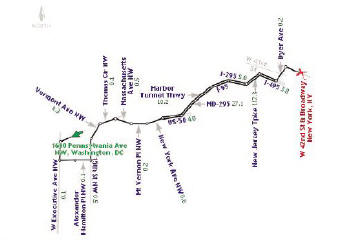 Mapping
Hacks
Mapping
HacksTips & Tools for Electronic Cartography
By Schuyler Erle, Rich Gibson, Jo Walsh
O'Reilly, 2005
Note: As we go to press, Mapping Hacks is due to be released this week and is available via sources such as Amazon.com, though it may take a few weeks to percolate into bookstores.A PDF update, covering Google Maps, is in production.
I was doing some writing for a project recently where I attempted to use the term "hacking." The powers that be vetoed it citing the term's negative connotation and how this project best not be associated with hacking.I suppose they've not been tuned into the new meaning of the term and the series of hacking books published by O'Reilly.The eloquent definition in the preface of the latest book in the series, Mapping Hacks, suits me fine: "Among people who write code, though, the term hack refers to a 'quick-and-dirty' solution to a problem, or a clever way to get something done.And the term hacker is taken very much as a compliment, referring to someone as being creative, having the technical chops to get things done.The Hacks series is an attempt to reclaim the word, document the good ways people are hacking, and pass the hacker ethic of creative participation on to the uninitiated. Seeing how others approach systems and problems is often the quickest way to learn about a new technology."
The book does indeed pass on the ethic.It's a combination of tips and tricks that allow users to better use mapping tools that are already out there, to tweak existing offerings to do more than might be expected and perhaps most importantly for the arm chair reader and "how does it work fan," to understand how all this stuff works.I enjoyed the explanations of why MapQuest got it wrong and how Fundrace was built (by the fellow who built it) as much as any part of the book.
The book includes nine chapters of hacks (a total of 100).Most are free; that is, they take advantage of free or open source offerings for the desktop and the Web.Many are low on the temperature gauge, doable by beginners, while others are "hot" and best left for experienced programmers.I'm pleased to report that even non-programmers can learn quite a bit from the more advanced hacks.
Part of the value of this tome (it's more than 500 pages) is the accessible descriptions of technology.Want to understand how wardriving works? Check page 69.Need to understand projections? That's page 120.The discussions are clear, and personable, as though your best friend were explaining it to you.And, that's nice since in the Foreward.respected geospatial "programmer for hire" Frank Warmerdam admits to wanting to share a copy with his mother, hoping she'll try some hacks.
Dividing the Hacks
The chapters are loosely based on geography (from your life, to your neighborhood, to the world), platforms (the Web, gadgets and the desktop), and other topics (geocoding and basic GIS functions, spatial data infrastructure and modeling).The introduction suggests picking and choosing what's of interest at any moment.I plowed straight on through and didn't find myself bored at all.
Some hacks are just introductions to websites that map geeks may already visit and use but that others, outside our community, have yet to visit.These include David Rumsey's website, Census' TIGER server and NASA's World Wind.Other chapters introduce online tools for changing decimal degrees to degrees/minutes/seconds, and for the real programmer, the tools to build his or her own app on the desktop using open source PROJ.4.
Tiny Tutorials
Don't expect lots of ESRI and MapInfo hacks in the book.Real hackers play with Manifold, GRASS and QGIS.They dabble in GDAL and Openmap. These mini-tutorials are quite good and walk through processes step by step.While reading them I kept getting ideas for science fair projects.(Teachers take note - this is a fabulous book for your budding programmer from about middle school on up!)
A chapter on building the geospatial Web provides a great introduction to the Open Geospatial Consortium's Web standards including discussions of GeoServer, MapServer, PostGIS and other technologies that implement the specifications.
 |
The authors have the good sense to step outside pure mapping hacks if it will help the reader get more use of the available tools.There's a hack discussing how to shorten URLs.Why? Because the URL of maps from MapQuest or Google Maps are terribly long and likely to get split when sent via e-mail, only to confuse the recipient.The book contains some nice critiques of services offered: how Google Local compares to Yahoo Local and what it is about Maporama that makes is far more interesting to amateur GPS orienteers.Want to know what GPS accessories to buy? There's a nice guide.And, yes, there are links to sites describing how to build your cable for your GPS.There's even a hack titled "What to Do if your Government is Hoarding Geographic Data" aimed at those who need data beyond the friendly "free for all" we have in the United States.
Get Creative
The book is as much about sharing what others have learned as it is about enabling new hacks.Just reading the "how to's" will get the creative juices flowing.Ever consider trying to evaluate routes based on trying to avoid getting your child car sick? Ever wonder why your TV reception is so poor? Such questions and answers can only spawn more hacking, which is just what the authors I believe, want to see.
 |